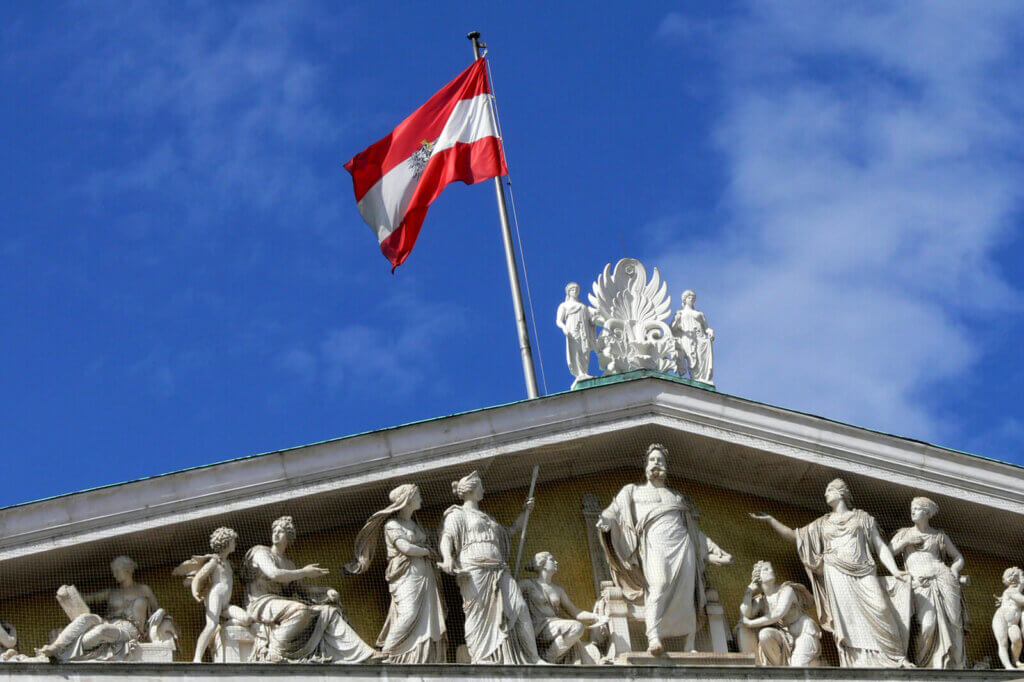In the gable field above the main entrance to the parliament building, the Viennese saw their emperor “in a nightgown” in the center. That scratched his image. Here, the 38-ton relief made of Lasa marble showed Emperor Franz Joseph I as a Roman emperor, dressed in a toga, giving the crown lands their constitution. The crown lands as allegorical female figures are recognizable by their respective coats of arms. The depiction of the monarch as a Roman emperor indicates the emperor’s self-image as an absolutist ruler guiding the destiny of the Austro-Hungarian Monarchy. Even if Franz Joseph’s gesture is intended to convey an invitation to the crown lands to rule with him, it leaves no doubt that the granting of the constitution is seen as a unilateral act of mercy on the part of the emperor, who retains central rights in his hands despite the now elected parliament. Emperor Franz Joseph I rejected the idea of parliamentarianism out of the deepest conviction until his death . With great self-confidence and in the belief in the divinely ordained task of his house for over 600 years, Emperor Franz Joseph I had committed himself to an absolutist centralist system . He only deviated from this under extreme pressure. At the age of 18, he issued the “octroyed March Constitution” without the participation of a parliament from Olomouc, where the ruling house had taken refuge from the revolution of 1848. At the same time, he had the country’s entire critical elite executed in Hungary. Formally, he already suspended the concessions with the New Year’s Patent of 1851. Peasant liberation, the unified customs system, unified citizenship, the separation of judiciary and administration, jury courts, and municipal autonomy have remained as legacies of the Revolution. The “February Patent” of 1861 is considered the birth certificate of Austrian parliamentarism . In the February Constitution, legislation was divided between the emperor and the two houses of the Imperial Council. The House of Representatives of the Imperial Council was to be formed by deputies delegated by the provincial parliaments. The Reichsrat, with 100 members, had an advisory function in financial and economic policy matters. However, this arrangement was rejected by Hungary and, to some extent, by Galicia as still too centralistic. Hungarian politicians boycotted them wherever possible. This manifesto was also partially revoked by the suspension patent as early as 1865. It was not until the defeat of the Prussian-Austrian War of 1866 and the high war debts that Emperor Franz Joseph I signed five basic state laws in 1867, which are also collectively known as the “December Constitution” . This general catalog of fundamental rights is still valid in Austria today and determines basic liberties such as equality before the law, freedom of faith and conscience, but also freedom of science and teaching. The Hungarians enforced the dual monarchy of Austria-Hungary. He only agreed to universal suffrage – for men only – when there were several large demonstrations on the Ringstrasse in 1905, while a revolution broke out in Russia that shook the Tsarist Empire. The proceedings in the House of Representatives, which were characterized by national struggles and conflicts, were not solution-oriented. In 1907, Vienna had the largest parliament in the whole of Europe with 526 deputies and a good 30 parties. The deputies could speak in German, Czech, Polish, Ukrainian, Croatian, Serbian, Slovenian, Italian, Romanian and Russian. There were no interpreters. Hours of continuous speeches blocked meetings. Although the free Babylonian spectacle was an attraction for tourists and Viennese, who could warm up in the heated visitors’ gallery during the cold season, it not only damaged the young parliamentarianism, but also the cohesion of the monarchy. Franz Joseph I never attended a sitting of the House and only entered the building twice: in 1879 for the Gleichenfeier and in 1884 after its completion. He could not show his aversion to constitutional development more clearly. “I am the last monarch of the old school. It is my duty to protect my people from their politicians!” said Franz Josef I to former US President Theodore Roosevelt in 1910. Time Travel Tip:The statue of Emperor Franz Joseph I can be found in the Burggarten near the Mozart statue. More information about him and his life can of course be found in the Sisi Museum and Schönbrunn Palace.
Image source:
https://commons.wikimedia.org/wiki/File:Wien-Parlament,Giebel_mit_Fahne.jpg?uselang=de





